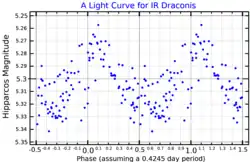8 Draconis
8 Draconis, formally named Taiyi /ˌtaɪˈjiː/,[11] is a single[12] star in the northern circumpolar constellation of Draco. Based upon an annual parallax shift of 34.14 mas as seen from the Earth,[13] the star is located approximately 96 light-years from the Sun. It is moving further away with a heliocentric radial velocity of +9 km/s,[7] having come within 40.6 ly some 2.6 million years ago.[5]
| Observation data Epoch J2000.0 Equinox J2000.0 (ICRS) | |
|---|---|
| Constellation | Draco |
| Right ascension | 12h 55m 28.550015s[2] |
| Declination | +65° 26′ 18.5079″[2] |
| Apparent magnitude (V) | 5.225[3] |
| Characteristics | |
| Spectral type | F1VmA7(n)[4] |
| B−V color index | 0.303±0.005[5] |
| Variable type | Gamma Doradus[6] |
| Astrometry | |
| Radial velocity (Rv) | +9.0[7] km/s |
| Proper motion (μ) | RA: −4.235[2] mas/yr Dec.: −30.174[2] mas/yr |
| Parallax (π) | 34.0276 ± 0.0922 mas[2] |
| Distance | 95.9 ± 0.3 ly (29.39 ± 0.08 pc) |
| Absolute magnitude (MV) | 2.90[5] |
| Details | |
| Mass | 1.56[8] M☉ |
| Radius | 1.50[8] R☉ |
| Luminosity | 5.75[5] L☉ |
| Surface gravity (log g) | 4.01[4] cgs |
| Temperature | 7,129[4] K |
| Metallicity [Fe/H] | −0.14[4] dex |
| Rotational velocity (v sin i) | 119.6[9] km/s |
| Age | 250±200[8] Myr |
| Other designations | |
| Database references | |
| SIMBAD | data |
This is an F-type main-sequence star with a stellar classification of F1VmA7(n).[4] It is a Gamma Doradus variable star with a brightness variation of about one tenth of a magnitude.[6] 8 Dra has a relatively high rate of rotation, showing a projected rotational velocity of 120 km/s.[9] The star has 1.56 times the mass of the Sun and 1.50 times the Sun's radius.[8] It is radiating 5.75[5] times the Sun's luminosity from its photosphere at an effective temperature of 7,129 K.[4] An infrared excess has been detected at wavelengths of 24 and 70μm, which suggests the presence of a circumstellar disk orbiting the star.[8]
Nomenclature
8 Draconis is the star's Flamsteed designation. It also received the variable star designation IR Draconis in 2000, after its variability had been discovered using Hipparcos photometry.[6]
The star bore the traditional Chinese name of Taiyi,[14] from 太乙 (Tài Yǐ) or 太一 (Tài Yī, the Great One), both of which refer to Tao. In 2016, the International Astronomical Union organized a Working Group on Star Names (WGSN)[15] to catalogue and standardize proper names for stars. The WGSN approved the name Taiyi for this star on 30 June 2017 and it is now so entered on the List of IAU-approved Star Names.[11]
References
- Aerts, C.; Eyer, L.; Kestens, E. (September 1998). "The discovery of new γ Doradus stars from the HIPPARCOS mission". Astronomy and Astrophysics. 337: 790–796. Bibcode:1998A&A...337..790A. Retrieved 4 January 2022.
- Brown, A. G. A.; et al. (Gaia collaboration) (August 2018). "Gaia Data Release 2: Summary of the contents and survey properties". Astronomy & Astrophysics. 616. A1. arXiv:1804.09365. Bibcode:2018A&A...616A...1G. doi:10.1051/0004-6361/201833051. Gaia DR2 record for this source at VizieR.
- Høg, E; Fabricius, C; Makarov, V. V; Urban, S; Corbin, T; Wycoff, G; Bastian, U; Schwekendiek, P; Wicenec, A (2000). "The Tycho-2 catalogue of the 2.5 million brightest stars". Astronomy and Astrophysics. 355: L27. Bibcode:2000A&A...355L..27H.
- Gray, R. O; Corbally, C. J; Garrison, R. F; McFadden, M. T; Robinson, P. E (2003). "Contributions to the Nearby Stars (NStars) Project: Spectroscopy of Stars Earlier than M0 within 40 Parsecs: The Northern Sample. I". The Astronomical Journal. 126 (4): 2048. arXiv:astro-ph/0308182. Bibcode:2003AJ....126.2048G. doi:10.1086/378365. S2CID 119417105.
- Anderson, E.; Francis, Ch. (2012), "XHIP: An extended hipparcos compilation", Astronomy Letters, 38 (5): 331, arXiv:1108.4971, Bibcode:2012AstL...38..331A, doi:10.1134/S1063773712050015, S2CID 119257644.
- Samus, N. N.; Durlevich, O. V.; et al. (2009). "VizieR Online Data Catalog: General Catalogue of Variable Stars (Samus+ 2007-2013)". VizieR On-line Data Catalog: B/GCVS. Originally Published in: 2009yCat....102025S. 1. Bibcode:2009yCat....102025S.
- Wilson, Ralph Elmer (1953). "General catalogue of stellar radial velocities". Washington. Bibcode:1953GCRV..C......0W.
- Plavchan, Peter; et al. (2009), "New Debris Disks Around Young, Low-Mass Stars Discovered with the Spitzer Space Telescope", The Astrophysical Journal, 698 (2): 1068–94, arXiv:0904.0819, Bibcode:2009ApJ...698.1068P, doi:10.1088/0004-637X/698/2/1068, S2CID 51417657.
- Schröder, C.; Reiners, Ansgar; Schmitt, Jürgen H. M. M. (January 2009), "Ca II HK emission in rapidly rotating stars. Evidence for an onset of the solar-type dynamo" (PDF), Astronomy and Astrophysics, 493 (3): 1099–1107, Bibcode:2009A&A...493.1099S, doi:10.1051/0004-6361:200810377
- "8 Dra". SIMBAD. Centre de données astronomiques de Strasbourg. Retrieved 2019-01-23.
- "Naming Stars". IAU.org. Retrieved 16 December 2017.
- Eggleton, P. P.; Tokovinin, A. A. (2008), "A catalogue of multiplicity among bright stellar systems", Monthly Notices of the Royal Astronomical Society, 389 (2): 869, arXiv:0806.2878, Bibcode:2008MNRAS.389..869E, doi:10.1111/j.1365-2966.2008.13596.x, S2CID 14878976.
- Van Leeuwen, F (2007). "Validation of the new Hipparcos reduction". Astronomy and Astrophysics. 474 (2): 653–664. arXiv:0708.1752. Bibcode:2007A&A...474..653V. doi:10.1051/0004-6361:20078357. S2CID 18759600.
- "WG Triennial Report (2015-2018) - Star Names" (PDF). p. 7. Retrieved 2018-07-14.
- "International Astronomical Union | IAU". www.iau.org. Retrieved 2018-01-16.
